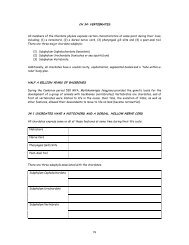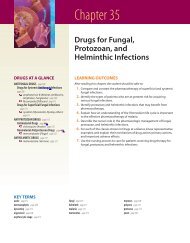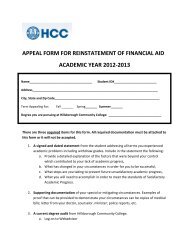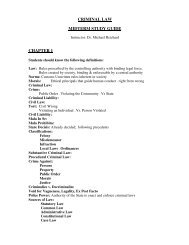Antimicrobial Drugs
Antimicrobial Drugs
Antimicrobial Drugs
Create successful ePaper yourself
Turn your PDF publications into a flip-book with our unique Google optimized e-Paper software.
M34_ADAM9811_03_SE_CH34.QXD 12/30/09 1:16 PM Page 496<br />
496 Unit 5 The Immune System<br />
NURSING PROCESS FOCUS<br />
PATIENTS RECEIVING ANTIBACTERIAL THERAPY<br />
Assessment<br />
Potential Nursing Diagnoses<br />
Baseline assessment prior to administration:<br />
■ Understand the reason the drug has been prescribed in order to assess for<br />
therapeutic effects.<br />
■ Obtain a complete health history including neurologic, cardiovascular, respiratory,<br />
hepatic or renal disease, and the possibility of pregnancy. Obtain a drug history<br />
including allergies, including specific reactions to drugs, current prescription and<br />
OTC drugs, herbal preparations, and alcohol use. Be alert to possible drug<br />
interactions.<br />
■ Assess signs and symptoms of current infection noting location, characteristics,<br />
presence or absence of drainage and character of drainage, duration, and<br />
presence or absence of fever or pain.<br />
■ Evaluate appropriate laboratory findings (e.g., CBC, C&S, hepatic and renal<br />
function studies).<br />
Assessment throughout administration:<br />
■ Assess for desired therapeutic effects (e.g., diminished signs and symptoms of<br />
infection and fever).<br />
■ Continue periodic monitoring of CBC, hepatic and renal function, urinalysis, C&S,<br />
peak and trough drug levels.<br />
■ Assess for adverse effects: nausea, vomiting, abdominal cramping, diarrhea,<br />
drowsiness, dizziness, and photosensitivity. Severe diarrhea, especially containing<br />
mucus, blood, or pus; yellowing of sclera or skin; and decreased urine output or<br />
darkened urine should be reported immediately.<br />
Planning: Patient Goals and Expected Outcomes<br />
The patient will:<br />
■ Experience therapeutic effects (e.g., diminished signs and symptoms of infection, decreased fever).<br />
■ Be free from, or experience minimal, adverse effects.<br />
■ Verbalize an understanding of the drug’s use, adverse effects, and required precautions.<br />
■ Demonstrate proper self-administration of the medication (e.g., dose, timing, when to notify provider).<br />
Interventions and (Rationales)<br />
Ensuring therapeutic effects:<br />
■ Continue assessments as described earlier for therapeutic effects. (Diminished<br />
fever, pain, or signs and symptoms of infection should begin after taking the first<br />
dose and continue to improve.The health care provider should be notified if fever<br />
and signs of infection remain after 3 days or if entire course of the drug has been<br />
taken and signs of infection are still present.)<br />
Minimizing adverse effects:<br />
■ Continue to monitor vital signs. Immediately report undiminished fever, changes<br />
in level of consciousness (LOC), or febrile seizures to the health care provider.<br />
(Fever should begin to diminish within 1 to 3 days after starting the drug. A<br />
continued fever may be a sign of worsening infection, adverse drug effects, or<br />
antibiotic resistance.)<br />
■<br />
Continue to monitor periodic lab work: hepatic and renal function tests, CBC,<br />
urinalysis, C&S, and peak and trough drug levels. (Many antibacterials are hepatic<br />
and/or renal toxic. Periodic C&S tests may be ordered if infections are severe or<br />
are slow to resolve to confirm appropriate therapy. Drug levels will be monitored<br />
with drugs with known severe adverse effects.)<br />
■<br />
■<br />
■<br />
■<br />
■<br />
■<br />
■<br />
Infection<br />
Pain (related to infection)<br />
Hyperthermia<br />
Deficient Knowledge (drug therapy)<br />
Risk for Injury (related to adverse drug effects)<br />
Risk for Deficient Fluid Volume (related to fever, diarrhea caused by<br />
adverse drug effects)<br />
Risk for Noncompliance (related to adverse drug effects, deficient<br />
knowledge, or cost of medication)<br />
Implementation<br />
Patient and Family Education<br />
■<br />
■<br />
■<br />
■<br />
Teach the patient to report a fever that does not diminish below<br />
100°F within 3 days; increasing signs and symptoms of infection; or<br />
symptoms that remain present after taking the entire course of the<br />
drug.<br />
Teach the patient to not stop antibacterial when “feeling better” but<br />
to take the entire course of antibacterial; do not share doses with<br />
other family members with similar symptoms; and return to the<br />
health care provider if symptoms have not resolved after entire<br />
course of therapy.<br />
Teach the patient to immediately report a fever that does not<br />
diminish below 100°F; febrile seizures; and changes in behavior or<br />
LOC to the health care provider.<br />
Instruct the patient on the need for periodic lab work.<br />
# 102887 Cust: PE/NJ/CHET Au: ADAMS Pg. No. 496<br />
Title: Pharmacology for Nurses Server: Jobs2<br />
C/M/Y/K<br />
Short / Normal<br />
DESIGN SERVICES OF<br />
S4CARLISLE<br />
Publishing Services

















